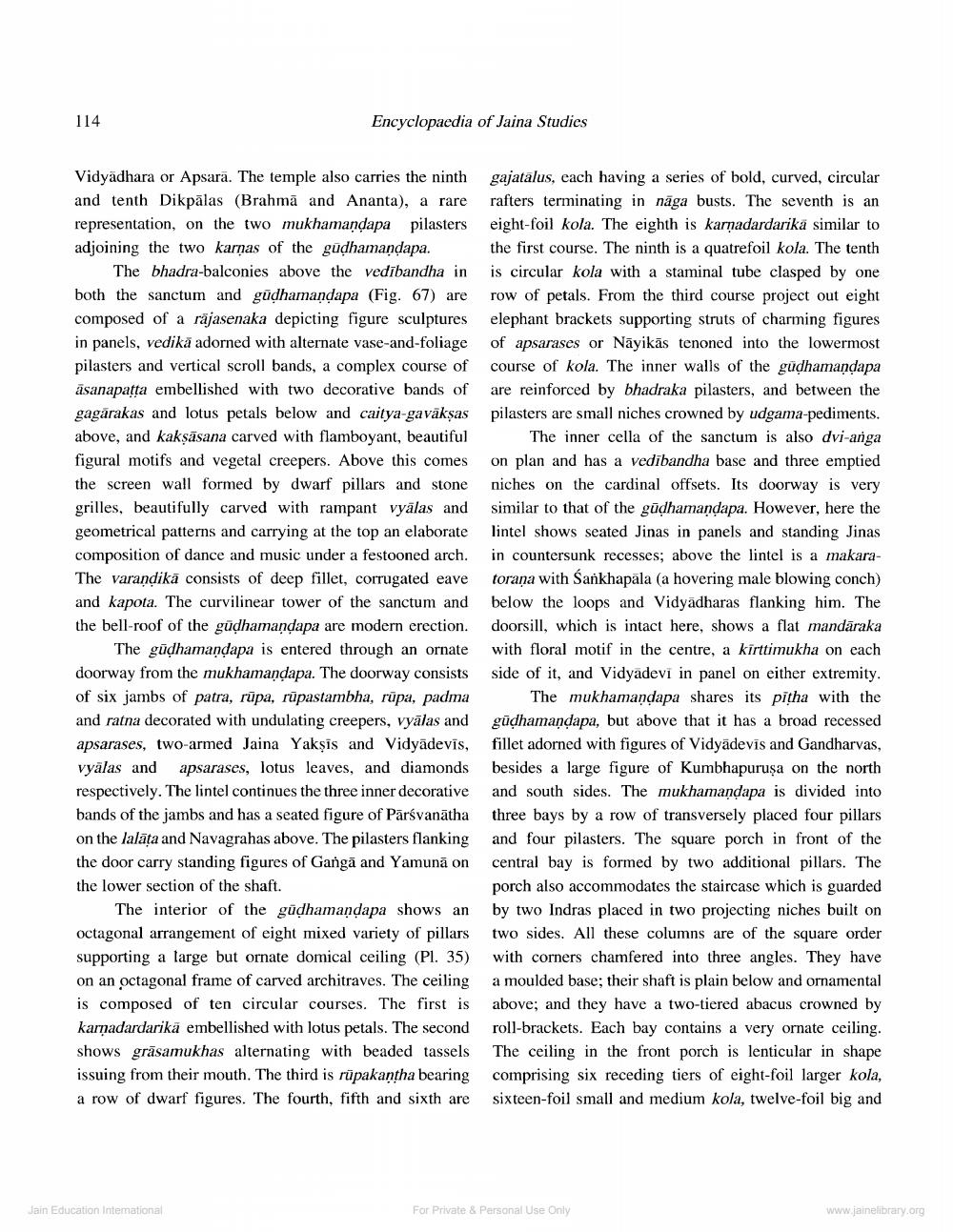________________
114
Encyclopaedia of Jaina Studies
Vidyadhara or Apsarā. The temple also carries the ninth and tenth Dikpālas (Brahmā and Ananta), a rare representation, on the two mukhamandapa pilasters adjoining the two karnas of the gudhamandapa.
The bhadra-balconies above the vedībandha in both the sanctum and gūdhamandapa (Fig. 67) are composed of a rājasenaka depicting figure sculptures in panels, vedika adorned with alternate vase-and-foliage pilasters and vertical scroll bands, a complex course of āsanapatta embellished with two decorative bands of gagárakas and lotus petals below and caitya-gavākṣas above, and kaksāsana carved with flamboyant, beautiful figural motifs and vegetal creepers. Above this comes the screen wall formed by dwarf pillars and stone grilles, beautifully carved with rampant vyālas and geometrical patterns and carrying at the top an elaborate composition of dance and music under a festooned arch. The varandikā consists of deep fillet, corrugated eave and kapota. The curvilinear tower of the sanctum and the bell-roof of the gūdhamandapa are modern erection.
The gūdhamandapa is entered through an ornate doorway from the mukhamandapa. The doorway consists of six jambs of patra, rūpa, rūpastambha, rūpa, padma and ratna decorated with undulating creepers, vyālas and apsarases, two-armed Jaina Yakṣis and Vidyādevīs, vyālas and apsarases, lotus leaves, and diamonds respectively. The lintel continues the three inner decorative bands of the jambs and has a seated figure of Pārsvanātha on the lalāta and Navagrahas above. The pilasters flanking the door carry standing figures of Gangā and Yamunā on the lower section of the shaft.
The interior of the gūdhamandapa shows an octagonal arrangement of eight mixed variety of pillars supporting a large but ornate domical ceiling (Pl. 35) on an octagonal frame of carved architraves. The ceiling is composed of ten circular courses. The first is karmadardarikā embellished with lotus petals. The second shows grāsamukhas alternating with beaded tassels issuing from their mouth. The third is rūpakantha bearing a row of dwarf figures. The fourth, fifth and sixth are
gajatalus, each having a series of bold, curved, circular rafters terminating in nāga busts. The seventh is an eight-foil kola. The eighth is karņadardarikā similar to the first course. The ninth is a quatrefoil kola. The tenth is circular kola with a staminal tube clasped by one row of petals. From the third course project out eight elephant brackets supporting struts of charming figures of apsarases or Nāyikās tenoned into the lowermost course of kola. The inner walls of the gudhamandapa are reinforced by bhadraka pilasters, and between the pilasters are small niches crowned by udgama-pediments.
The inner cella of the sanctum is also dvi-anga on plan and has a vedībandha base and three emptied niches on the cardinal offsets. Its doorway is very similar to that of the gūdhamandapa. However, here the lintel shows seated Jinas in panels and standing Jinas in countersunk recesses; above the lintel is a makaratorana with Sankhapāla (a hovering male blowing conch) below the loops and Vidyadharas flanking him. The doorsill, which is intact here, shows a flat mandāraka with floral motif in the centre, a kīrttimukha on each side of it, and Vidyadevi in panel on either extremity.
The mukhamandapa shares its pitha with the gūdhamandapa, but above that it has a broad recessed fillet adorned with figures of Vidyādevis and Gandharvas, besides a large figure of Kumbhapuruṣa on the north and south sides. The mukhamandapa is divided into three bays by a row of transversely placed four pillars and four pilasters. The square porch in front of the central bay is formed by two additional pillars. The porch also accommodates the staircase which is guarded by two Indras placed in two projecting niches built on two sides. All these columns are of the square order with corners chamfered into three angles. They have a moulded base; their shaft is plain below and ornamental above; and they have a two-tiered abacus crowned by roll-brackets. Each bay contains a very ornate ceiling. The ceiling in the front porch is lenticular in shape comprising six receding tiers of eight-foil larger kola, sixteen-foil small and medium kola, twelve-foil big and
Jain Education Intemational
For Private & Personal Use Only
For Private & Personal Use Only
www.jainelibrary.org




